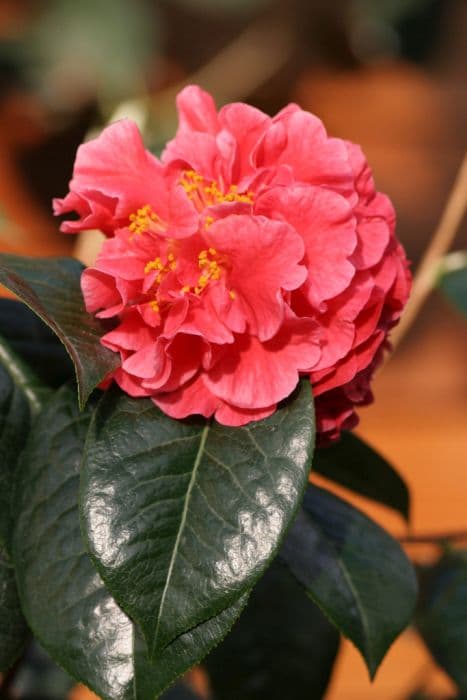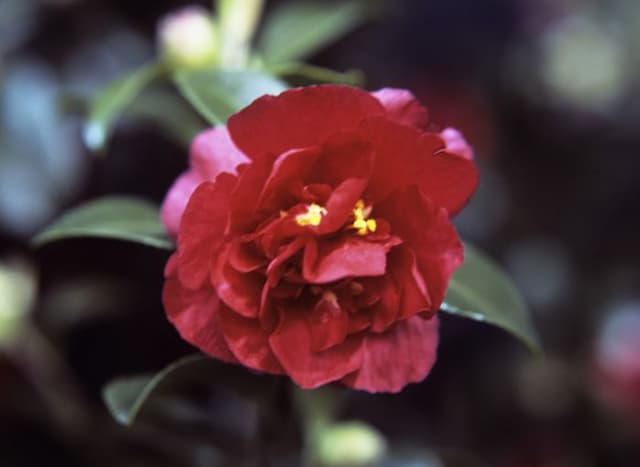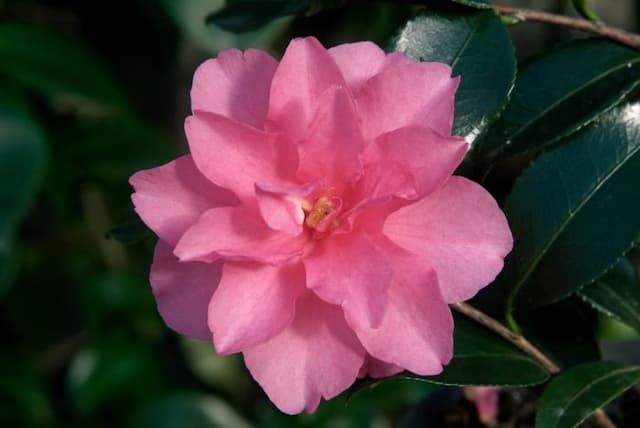Japanese Camellia Camellia japonica 'Gloire de Nantes'

ABOUT
Camellia japonica 'Gloire de Nantes', commonly known as Japanese camellia, is an ornamental plant that boasts a striking appearance with glossy, dark green leaves. The leaves have a leathery texture and are oval-shaped with finely serrated edges, creating a lush backdrop for its showy flowers. This variety, 'Gloire de Nantes', is particularly known for its beautiful blooms. The flowers are large and peony-like, typically featuring a rich, vibrant pink color that can vary in shade from almost red to a softer pink. Each bloom consists of numerous layers of petals that form a full, rounded shape, adding a touch of elegance to the garden setting. The flowers have bright yellow stamens at their center, creating a striking contrast against the pink petals. The plant has a natural elegance with its combination of deep green foliage and flamboyant flowers, making it a prized addition to any garden for its ornamental value.
About this plant
 Names
NamesFamily
Theaceae
Synonyms
Japanese Camellia, Common Camellia, Rose of Winter
Common names
Camellia japonica 'Gloire de Nantes'.
 Toxicity
ToxicityTo humans
Camellia, the most common name for Camellia japonica 'Gloire de Nantes', is not toxic to humans. Ingesting any part of the plant typically does not lead to poisoning or adverse health consequences.
To pets
Camellia is generally considered non-toxic to pets. Ingesting parts of the plant should not cause any significant symptoms of poisoning or lead to dangerous consequences for animals such as cats and dogs.
 Characteristics
CharacteristicsLife cycle
Perennials
Foliage type
Evergreen
Color of leaves
Green
Flower color
Pink
Height
6-10 feet (1.8-3 meters)
Spread
6-10 feet (1.8-3 meters)
Plant type
Shrub
Hardiness zones
7
Native area
Japan
Benefits
 General Benefits
General Benefits- Aesthetic Appeal: Camellia japonica 'Gloire de Nantes', commonly known as Japanese camellia, is prized for its beautiful, large, rose-like flowers that add visual interest to gardens.
- Year-Round Foliage: This plant provides evergreen foliage that remains attractive throughout the seasons, contributing to the garden's greenery even in winter.
- Landscape Versatility: Japanese camellia can be used in different landscape situations such as specimen planting, hedges, and foundation plantings.
- Shade Tolerance: It can thrive in partial shade conditions where other plants might struggle, making it suitable for shaded gardens.
- Low Maintenance: Once established, it requires relatively low maintenance, needing only occasional pruning and consistent moisture.
- Long Blooming Period: The blooming period extends from late winter through spring, providing flowers when few other plants are in bloom.
- Wildlife Attraction: The flowers can attract pollinators like bees and butterflies, benefiting the garden ecosystem.
 Medical Properties
Medical PropertiesThis plant is not used for medical purposes.
 Air-purifying Qualities
Air-purifying QualitiesThis plant is not specifically known for air purifying qualities.
 Other Uses
Other Uses- As a natural fabric dye: The petals of Camellia can be used to create natural dyes for textiles, imparting soft hues to fabrics.
- Ink for Artwork: The pigments extracted from the Camellia can be used in the production of botanical inks for drawing or calligraphy.
- Photography: The distinct patterns and colors of Camellia japonica flowers serve as an excellent subject for botanical photographers.
- Floral arrangement training: Camellias are popular for use in training floral designers due to the flower’s structure, providing a good model for arranging techniques.
- Cultural ceremonies: In some cultures, Camellias are used in traditional ceremonies for their symbolic meanings, such as longevity and gratitude.
- Hair adornments: In certain regions, the blossoms of Camellia are worn in the hair for special occasions, such as weddings or traditional dances.
- Floating decorations: The flowers of Camellia japonica can float in water, making them suitable as decorations for bowls or small water features."
- Educational tool: Camellias can be utilized in schools or botanical studies to teach students about plant biology and horticulture.
- Culinary garnish: Although not widely recognized for its edibility, the non-toxic Camellia flowers can occasionally be used to garnish dishes, adding a touch of elegance.
- Craft projects: Dried Camellia petals can be used in various craft projects, including the creation of homemade potpourri or as natural confetti.
Interesting Facts
 Feng Shui
Feng ShuiThe Camellia is not used in Feng Shui practice.
 Zodiac Sign Compitability
Zodiac Sign CompitabilityThe Camellia is not used in astrology practice.
 Plant Symbolism
Plant Symbolism- Desire or Passion: Camellias often symbolize desire or deep passion, much attributed to their rich, colorful petals and luxurious appearance.
- Admiration: Gifting Camellias can indicate one's admiration towards another, showcasing respect and reverence.
- Perfection: Owing to its perfect form and beauty, Camellia japonica can represent the ideal or perfection in a person or situation.
- Longevity: As Camellias are long-lived plants with a lengthy blooming season, they often symbolize long-lasting devotion or life.
- Love: The Camellia, especially in hues of red like those of 'Gloire de Nantes', is a flower symbolizing love and affection – a sentiment often conveyed on Valentine’s Day or other romantic occasions.
- Refinement: The sophisticated look of the Camellia is sometimes associated with refined beauty and elegance.
- Faithfulness: In some cultures, Camellias are seen as a sign of faithfulness and loyalty in a relationship.
 Water
WaterCamellia japonica, commonly known as the Japanese camellia, requires consistent moisture without being waterlogged. During active growth in the spring and summer, water the plant once a week with about 1-1.5 gallons, depending on the size of the plant and the weather conditions. In the cooler months, reduce the frequency to every other week or when the soil feels dry to the touch about an inch below the surface. It's crucial to water deeply and slowly, allowing the water to reach the roots rather than just wetting the surface. Always use a gentle flow to avoid disturbing the soil around the base of the plant.
 Light
LightThe Japanese camellia thrives in partial shade, preferring bright but indirect light. An ideal spot would be under the dappled shade of taller trees where it can be protected from the harsh afternoon sun. Direct sunlight, particularly during the hottest parts of the day, can lead to leaf scorching.
 Temperature
TemperatureJapanese camellias perform best in temperatures ranging from 60 to 75 degrees Fahrenheit. They can tolerate short periods of colder weather down to about 20 degrees Fahrenheit but should be protected from strong, cold winds. The ideal growing condition for this plant is a cool and stable environment without extreme temperature fluctuations.
 Pruning
PruningPrune the Japanese camellia to maintain shape and remove any dead or weak growth, which also helps in preventing diseases by increasing air circulation. The best time to prune is just after the blooms have faded, usually in late winter or early spring, to ensure buds are not removed for the next season. Lightly prune by cutting back the branches to just above the nodes where new growth can emerge.
 Cleaning
CleaningAs needed
 Soil
SoilJapanese Camellia prefers acidic, well-draining soil with a pH of 5.5 to 6.5. A mix of peat, fine bark, and perlite in equal parts is ideal to provide the necessary conditions.
 Repotting
RepottingJapanese Camellias should be repotted every 2-3 years or when rootbound, ideally in spring before the growth season starts.
 Humidity & Misting
Humidity & MistingJapanese Camellias thrive best in moderate to high humidity levels, around 40-50% is generally preferred, avoiding overly dry air.
 Suitable locations
Suitable locationsIndoor
Place in bright, indirect light, avoid dry heat sources.
Outdoor
Plant in dappled shade, protect from strong winds.
Hardiness zone
7-9 USDA
 Life cycle
Life cycleThe Camellia japonica 'Gloire de Nantes', commonly known as the Japanese camellia, begins its life cycle from a seed, which germinates to develop into a seedling. The seedling stage is characterized by the growth of the primary root and shoot. As the plant matures and enters the vegetative stage, it develops a woody stem and glossy, evergreen leaves. During the blooming stage, typically in late winter to early spring, it produces its showy flowers that range in color from pink to red. After pollination, which is carried out by insects, the plant produces a dry capsule fruit containing seeds, allowing for the dispersal and continuation of the life cycle. Post-reproduction, the camellia enters a period of dormancy or reduced activity before the cycle begins anew with the next growing season.
 Propogation
PropogationPropogation time
Spring-Early Summer
Propogation: For Camellia japonica 'Gloire de Nantes', also known as Japanese camellia, the most popular method of propagation is through semi-hardwood cuttings. This typically takes place in late summer or early fall, after the current year's growth has begun to mature. The cutting should be about 4 to 6 inches (about 10 to 15 centimeters) long and include several leaves. After removing the lower set of leaves to expose the nodes, the cut end of the cutting is often dipped in rooting hormone to encourage root development. Then the cutting is placed in a well-draining soil mixture, with the leafless part buried. The cutting should be kept moist and in a warm place with indirect light until roots develop, which can take several weeks. Covering the cutting with a plastic bag can help maintain humidity, but it's important to remove it periodically to prevent mold growth.









